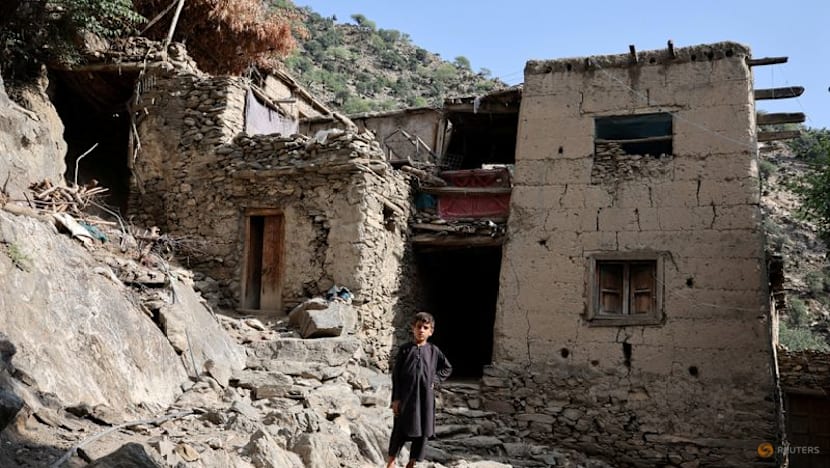Commentary: Afghanistan’s earthquake is a force multiplier of fragility
The latest disaster is another blow to isolated communities already reeling from food insecurity, drought and mass refugee returns, say these writers.

A boy stands in front of houses damaged by a deadly earthquake that struck Afghanistan's Kunar and Nangarhar provinces, at Masud village in Nurgal district, Kunar province, Afghanistan, Sep 4, 2025. REUTERS/Sayed Hassib
KABUL: After four decades of war in Afghanistan, an earthquake is just one more serving of misery. The disasters this week have claimed more than 2,200 lives and injured over 3,000 people, deepening an already dire situation since the Taliban’s return to power. In 2023, another quake killed 1,300 in the west of the country.
The powerful earthquake on Sep 1 struck four eastern provinces of Afghanistan, with Kunar bordering Pakistan suffering the worst casualties. Mud homes simply disintegrated.
The shock collides with the country’s overlapping humanitarian and political crises. International aid has further dwindled in 2025, with the United States leading the cutbacks, followed by Britain, France and Sweden.
The 6.0-magnitude earthquake that struck near Jalalabad, with the toll expected to rise as rescue teams – made up of officials, volunteers, and villagers – struggle to reach remote terrain and rocky hills in mountain communities in Nangarhar, Nuristan, Laghman and Kunar. Landslides triggered by the tremors have blocked key roads, further hampering relief efforts.
Abdullah, 33, his clothes caked in dust as he stood among the dead, having lost 17 family members and siblings, spoke through the ruins: “I don’t want your money, your food, water, or shelter. Nothing. Just send me air support to carry these bodies down to flat ground so I can bury them.”
His words, shared widely on social media, underscored the raw grief that no aid package could ease.
AFGHANISTAN’S MOMENT OF DEEP FRAGILITY
The Taliban authorities – whose regime is formally recognised only by Russia – have called for international assistance. In response, the United Nations has released emergency funds, and the United Kingdom has announced £1 million (US$1.35 million) in aid. Australia, the United Arab Emirates, South Korea and several other countries have pledged some humanitarian assistance.
But many traditional donors – most notably the United States – remain on the sidelines.
The shallow depth of the quake, at only eight kilometres beneath the surface, made it particularly destructive. Survivors described frantically digging neighbours out of collapsed mud-brick homes in the middle of the night. The tremors rippled to Islamabad, Pakistan’s capital, but without significant casualties reported.
Afghanistan sits atop active seismic fault lines. In 2023, three quakes in Herat province in the West killed nearly 1,300 people. In 2022, a temblor in the southeast killed at least 1,000, with Taliban officials claiming more than 4,000 fatalities. The country’s broken, fragile infrastructure and widespread poverty magnify the impact.
The latest earthquake has struck Afghanistan at a moment of deep fragility. Since the Taliban’s takeover in 2021, global assistance has steadily declined, largely in response to the regime’s harsh restrictions on women’s rights, including the ban on girls’ education.
The United States, once the country’s biggest donor, has cut nearly all of its support, while European nations have also scaled back. By 2025, less than one-third of Afghanistan’s humanitarian needs will be met, even as more than half of the country’s 42 million people depend on aid for survival, according to the United Nations.
The strain is worsened by the mass returns of Afghan refugees. In recent months, more than two million people have been expelled or pressured to leave neighbouring Pakistan and Iran, swelling the number of those in need just as donor support declines. Many were on the move back into Afghanistan when the quake struck.
NOT A STAND-ALONE DISASTER
Aid agencies warn that Afghanistan’s quake response is faltering under chronic underfunding: local resources had already been stretched thin with just 28 per cent of this year’s humanitarian appeal met.
“The earthquake is not a stand-alone disaster,” the UN stresses, but another blow to communities already reeling from food insecurity, drought, and mass refugee returns.
Afghanistan is rich in underground resources, and Kunar is one of its most resource-endowed provinces. For years, warlords and local influencers have exploited the area, engaging in looting, smuggling, and unregulated mining and timber trafficking into Pakistan. Kunar also contains vast forests, where massive deforestation has contributed to flooding and landslides.
The current quake underscores Afghanistan’s cycle of compounded crises. Decades of conflict, political isolation and systemic corruption during 20 years of international involvement have left provinces like Kunar among the poorest in the country. International sanctions have reduced aid flows, while ongoing displacement has swollen the ranks of the vulnerable.
Disasters such as the recent earthquake then inflict disproportionate suffering. The Taliban’s limited resources, coupled with their international pariah status, leave millions of Afghans dependent on overstretched UN agencies and NGOs for survival.
For Afghanistan, earthquakes are not just geological events – they are force multipliers of fragility, exposing the costs of isolation and the steep price paid by everyday people. Unless international engagement increases, each disaster risks tipping the country further into humanitarian freefall.
Humayoon Babur is a freelance journalist and researcher who covers Afghanistan. Abid Ahsad is a Kabul-based journalist. This commentary first appeared on Lowy Institute’s The Interpreter.














